The 70mm Promotion Tour
|
This article first appeared in |
| Written and photographed by: Thomas Hauerslev. Reedited slightly for the internet in April 2001. | Issue 37 - February 1995 |
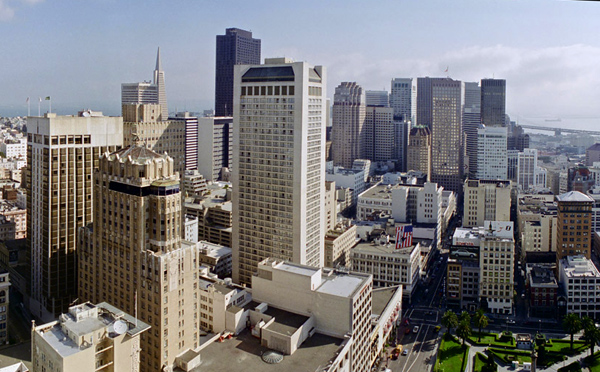 View
of San Francisco skyscrapers
with the iconic Transamerica Pyramid (1972) building in the back to the
left. Union Square below right. View
of San Francisco skyscrapers
with the iconic Transamerica Pyramid (1972) building in the back to the
left. Union Square below right.In very early January 1994 Johan Wolthuis, secretary of The International 70mm Association, approached me with the idea of a 70mm promotion tour to Los Angeles. After a lot of preliminary work we finally decided to go from October 1 - 15. 1994. The aim was to tell Hollywood how enthusiastic movie lovers are about original 70mm films. Before we left Europe we had made lists of 70mm films and lists of European cinemas capable of showing 70mm prints. Although we had made arrangements to visit a variety of companies in Los Angeles and San Francisco, we never had expected the openhearted enthusiasm we received by everyone. People we met and talked to was very positive about 65mm/70mm. Everyone was convinced by the superiority of 70mm and was quite surprised to meet two people coming all the way from Europe with this message about 70mm. • Go to gallery 70mm Tour: San Francisco, October 2 - 6, 1994 • Go to gallery 70mm Tour: Los Angeles, October 7 - 15, 1994 Is there a conclusion to The 70mm Promotion Tour to Los Angeles? Well, difficult question. Everyone we spoke with agreed that it will take Mr Spielberg and Mr Lucas to give 65mm cinematography the big push ahead before anyone will touch it. It all boils down to one thing: MONEY. The post production ads to the budget. The 65mm stock costs and so does 65mm camera equipment. Todd-AO and Panavision has all the cameras the industry will need. Arriflex in Germany has the ARRIFLEX 765 sitting on the shelf waiting. A lot of 65mm equipment is around to serve the industry. Everybody was very enthusiastic about 70mm films. Everyone had their story about 70mm and their theory why nobody shoots in 65mm. Digital sound takes much of the blame. I feel that digital sound is a blessing, however, only when it is combined with 70mm. The joke around town [LA] was the abbreviation of the 35mm digital sound format SDDS "Still Doesn't Do Shit". The interest to shoot in 65mm is definitely there. It is only a matter of a few years before filmmakers realize that it takes large pictures to lure the audience back into the cinema. Hopefully we are still around to see it. I would like to thank our sponsors: Mr Albert Bert, chairman of directors of the Kinepolis Group, Belgium, Mr Tom Odems, manager of Theater aan de Parade in the Netherlands and Mr Vittore Nicelli, president of Cinemeccanica, Italy who generously sponsored the tour. In Los Angeles we were invited to stay with chief projectionist at Todd-AO/Glen Glenn Studios, Mr Dan Leimeter. We are very grateful to Dan and his wife Barbara for housing us for ten days. Mr Chris Jenkins, manager of Todd-AO/Glen Glenn Studios, is also to be thanked for letting us use the facilities at 1021 North Seward Street. There is no way of describing all things we experienced during our tour. What follows is a day-by-day account of some of the magic called Hollywood. |
Further
in 70mm reading: |
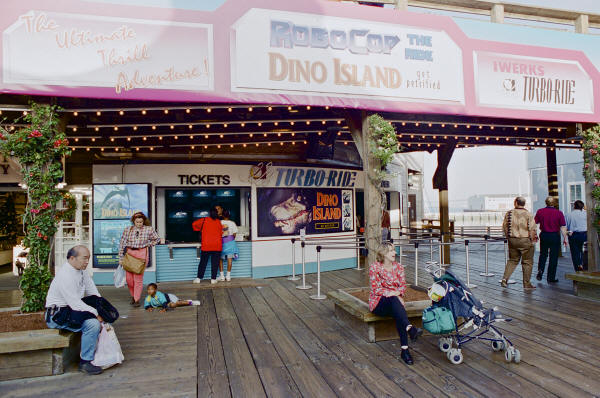 70mm
iWERKS Turbo Ride style at Pier 39 in San Francisco 70mm
iWERKS Turbo Ride style at Pier 39 in San Francisco02.10.1994. Arrived in San Francisco airport at 5 PM. Johan picked me up and we went directly to the hotel near Chinatown. From the open window on the 4th floor I could hear the sound of a police car. Just like the movies. After a long day I was very tired. I went to bed at 9 PM. 03.10.1994. Across the street we found a French café which turned out to be very nice and we spent all our San Francisco breakfasts at the café. French croissants in America. Johan told me about his Canada tour and we went over the newspaper to see if any films were presented in 70mm. "My Fair Lady" at the AMC Kabuki 8 and "True Lies" at the UA Coronet. Quickly we decided to see "My Fair Lady" the same evening. The UA Coronet, by the way, was the first Todd-AO house in San Francisco. We split up and I spent the day walking around San Francisco. I saw the Iwerks installation on Pier 39. Two films were shown. "RoboCop: The Ride" and "Dino Island". None of them created much fuss. Both films were shown in the 8/70 70mm format. After dinner we went to see "My Fair Lady". Quickly Johan found the manager Mr Michael Goodwin who showed us the complex. He gave us two tickets. The film looked like a blow-up from 35mm. It was very grainy and the dialogue came from the center channel alone. No panning of the sound. There was nothing wrong with the sound system in the cinema Mr Goodwin assured us. 04.10.1994. Tried to get in touch with Lucas Film but due to conflicts in our calendars a meeting could not be arranged. Spent some time looking for the San Francisco office of the Todd-AO Corporation on 172 Golden Gate Avenue. The two story building was in the seedy part of town. While the rain was poring down I was looking for no 172. Unable to find any signs indicating "Todd-AO", I asked for help in a shop. Finally I managed to ring a bell and a lady appeared and told me that the staff of two, Mr Ron Zimmerman and Mrs Edith, were on holiday. They would be back next week. In the afternoon Johan and I met in front of the Alhambra. A lovely old cinema with 70mm, Dolby Digital sound and a DP70 projector. The DP70 projector is called Norelco in the States, but in this article it is referred to as the DP70. The Alhambra was recently restored to one single screen after many years as a two screen cinema. Later the same day we went to see the Castro cinema. Castro is a beautiful old revival cinema with an original Würlitzer organ installed. The neon sign on the marquee in front is the pride of the cinema. |
Dear Mr
Hauerslev, Georges Lucas' office asked us to follow-up with you regarding your 70mm Promotion Tour. We are sorry to have missed the opportunity to meet you during your trip to the West Coast due to conflicts in our scheduling. The THX office would be pleased to host a meeting with you next time you visit this area. You may contact me directly for any such scheduling. We look forward to the possibility of seeing you in the near future and hearing of your groups actives. Best regards Kimberly Yost Marketing manager Lucasfilm Ltd THX Division P.O.Box 2009 San Rafael California 94912 USA |
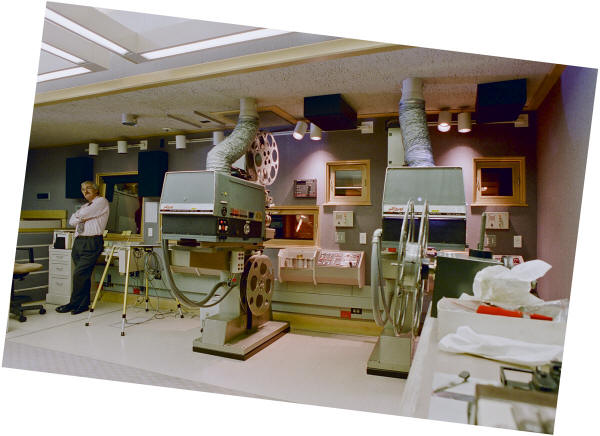 Vice
president of
Dolby Laboratories Inc
Mr Ioan Allen, gave us full demonstration of Dolby Digital sound Vice
president of
Dolby Laboratories Inc
Mr Ioan Allen, gave us full demonstration of Dolby Digital sound05.10.1994. At 11 AM Mr Ioan Allen, vice president of Dolby Laboratories Inc would give us full display of Dolby sound. Mrs Karen Lansdon assistant to Mr Allen, guided us through the many offices of Dolby Laboratories Inc. Finally we ended in the The Presentation Studio where Mr Allen was waiting. He had prepared to show us a reel of 70mm from "The Island" with Michael Caine. Realizing the reel had faded and the sound was not very good he stopped the DP75 projector and ran reel #1 of "The Fugitive" instead. Dolby Digital at its best. Upon asking, Mr Allen assured us that Dolby Digital sound could be applied to 70mm film if there is a demand. So far the industry has not shown any interest in it. The cinema itself had around 50 seats and was luxurious designed. The screen masking was moveable both horizontal and lateral. We also met Mr Lonny Jennings, film technician. I spent the afternoon with Lonny while Johan went of for himself to find some books. It was our last day in San Francisco. 06.10.1994. Left San Francisco by train for Los Angeles with the Coast Starlight at 07:55 AM. We arrived at Glendale railway station, one hour late, at 9 PM. Dan was there to meet us. 07.10.1994. We began our first day in Los Angeles at Todd-AO/Glen Glenn Studios, 1021 North Seward Street. After a few phone calls to Mikael Salomon, Richard Vetter, Panavision Inc, Showscan and 70mm Inc we drove to the UA Pasadena Cinema to see a demonstration of the new 35mm, 2 ½ perf, 24 fps film format. A Century projector had been converted to show 2 ½ perf. A reel from "Scent of a Woman" had been printed to this format. Apart from a slight travel ghost, the picture quality was outstanding. The picture steadiness was remarkable due to the slower film speed. The format is called CDP = Compact Distribution Print, a United Artists Theatres/Todd-AO development. The sound quality meets or exceeds SMPTE standards and is compatible with all known digital sound formats. After a short lunch we toured Todd-AO/Glen Glenn Sound with Dan. |
Gentlemen, It was a pleasure meeting with you earlier this week during your trip to Los Angeles for the 70mm Promotion Tour. As we discussed, MGM/UA is a strong supporter of improving both the sight and sound presentation of motion pictures. I shall be in touch with UIP to determine what can be done to strike some new prints of our 70mm library. Please keep me informed of your progress and my best wishes for your continual success. Sincerely Larry D. Gleason President Worldwide Theatrical Distribution MGM/UA Distribution Company 2500 Broadway Street Santa Monica California 90404-3061 USA |
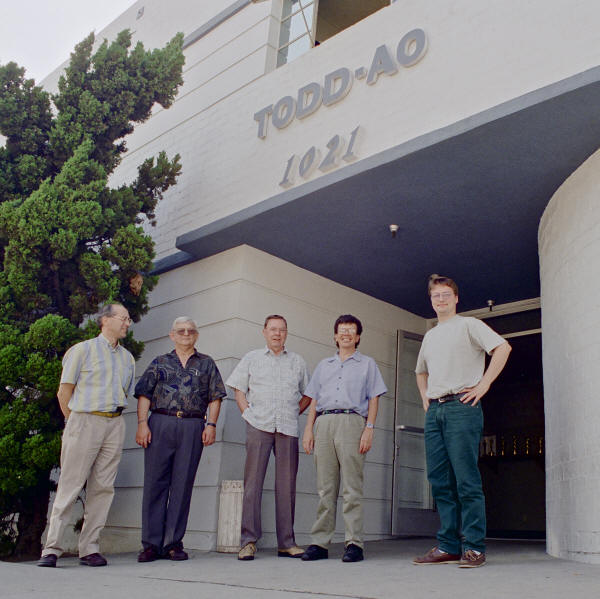 Outside
Todd-AO Studios at 1021 North Seward Street. From
left:
Johan
Wolthuis, Dan Leimeter, Richard Vetter, Darryl Gray and Thomas Hauerslev
outside the Todd-AO Studios Outside
Todd-AO Studios at 1021 North Seward Street. From
left:
Johan
Wolthuis, Dan Leimeter, Richard Vetter, Darryl Gray and Thomas Hauerslev
outside the Todd-AO StudiosIn the foyer of Todd-AO there is a display of 5 original Academy Awards. The first was awarded to Mr Michael Todd for the development of the Todd-AO system. Remaining Oscars was awarded to Todd-AO for best sound in "South Pacific", "West Side Story", "The Alamo" and "The Sound of Music". In the old days Oscars for best sound was awarded to the studio unlike today where the mixers receive the Oscar for best sound. Todd-AO/Glen Glenn Studio is the worlds largest sound studio. Stage A is the largest at 1021 Seward. It is a very large curved screen and the throw is 81 feet. Many great films have been mixed at Stage A "Close Encounters of the Third Kind" (took 14 weeks!), "E.T. - The Extra Terrestrial" and "Hook" to name a few in 70mm. The projectors are the DP70 prototypes made in 1955. They are still running beautifully although they could use some new paint. At Stage B "Out of Africa" was mixed among many others. The projectors here are also the DP70. At the opposite side of the street the previous Glen Glenn Sound is located. At Stage 1 a pair of DP70s from the ship "France" have been installed. Most of the Todd-AO/Glen Glenn Studio administration is located in the Glen Glenn building. It is a giant jigsaw puzzle to coordinate the use of all stages. Usually the planning lies months ahead, however, quite often appointments are booked from day to day if the studio is available. On our way home we visited the CBS Burbank Studio. Here, Todd-AO also has a huge studio complex for music recording (soundtrack). 08.10.1994. It was a beautiful day. From Dan's house, on top of the hill in Glendale, overlooking Los Angeles, we could see as far as Palos Verdes Peninsula, which is a rare experience in LA. We could even see The Pacific Ocean. Magnificent. Dan had arranged a visit to the Los Angeles Theatre on Broadway. This magnificent cinema closed in April 1994. It was built by S Charles Lee and opened January 30, 1931 with "City Lights". Los Angeles Historic Theatre Foundation held a meeting that morning to discuss ways of keeping the theatre open as a live stage theatre. The day we also met Mr Robert G Dickson. In the afternoon we visited The Hollywood Bowl and The Hollywood Studio Museum. None of it had anything to do with 70mm, but it was our day off. I felt a very strange sensation while walking in front of Mann's Chinese Theater and El Capitan. Had I been there before? Surely I have seen many films taking place in LA but this was strange. |
|
 Large
format 70mm film on pallets at CFI Large
format 70mm film on pallets at CFI09.10.1994. Thanks to the curtsey of the Leimeters we were taken on a guided tour in Los Angeles lasting a whole day. In an air-conditioned car at the size of a school bus we began in "beautiful downtown Burbank" seeing the gates of Walt Disney and Warner Brothers studios. Should the Leimeters ever loose their regular jobs, they can easily change business and become tourist guides. Almost every building in Hollywood had their story and Dan and Barbara kept telling them. To our full enjoyment. The building where Norma Jean (later Mrs Monroe) went to school, the house that served as inspiration to the house in "Psycho". Echo Park where "Chinatown" was filmed etc, etc. By the Pacific we saw the road used in the climax of "It's a Mad, Mad, Mad, Mad World". Los Angeles city has served as back lot to many films. Our first week was coming to an end. Excited as we were we had no idear of what next week would bring. 10.10.1994. Our first arrangement was at CFI at 10:30 with Mr Jack West, director 70mm sales and marketing. An informal discussion about 70mm soon developed and evolved into a tour at the 65mm/70mm laboratory. CFI handles IMAX, Iwerks and other special format 70mm films. The rest of the day was devoted to screenings at Todd-AO. Dan had arranged for us to see reel one of "Oklahoma!", "The Miracle of Todd-AO" and the Cinespace 70 demonstration film from 1986. The Cinespace 70 process is basically Todd-AO. Everything was presented in 70mm at Stage A. Also present at the screening were Dr Richard Vetter, and assistant Mr Darryl Gray of Todd-AO's camera division. Besides being manager of Todd-AO's camera department Dr Vetter is also known for the Dimension-150 process. Todd-AO/Glen Glenn Studios is still very active in the camera business and has a wide variety of 65mm cameras ready for hire. 11.10.1994. Meeting with Mr Larry D Gleason, president of worldwide theatrical distribution at MGM 10 AM. Discuss 70mm print politics. We explained to Mr Gleason there is a growing interest in Europe towards showing older films in 70mm. 70mm prints are, however, not available. Mr Gleason explained that MGM Classics department in the US made a profit in 1993 of 1.000.000 US dollars. Only thing they did was to distribute classic MGM films to cinemas in the States. At the moment "2001: A Space Odyssey" and "West Side Story" were available in 70mm in the States. We suggested a similar thing could be done in Europe. Have a few prints running without subtitles in the original version. The 70mm prints should be transferred from country to country. It is only a matter of co-ordination. Mr Gleason promised to look into the possible striking of new 70mm prints for Europe. In the afternoon we went inside the Paramount Pictures studio lot to see a TV- show rehearsal and the brand-new Paramount Theater. We met with chief projectionist Bob Miller who explained that he bought 7 (seven) DP70 for 3.000 US dollars. He built 3 complete projectors from them and had them installed. The new cinema houses 528 seats and the screen is 16,5 x 7,6 meters. I asked him why he chose to use a 40 years old projector. He answered promptly, "because it is the best projector available". 4 years ago Paramount Pictures bought some Century projectors, and they are still not living up to expectations. |
|
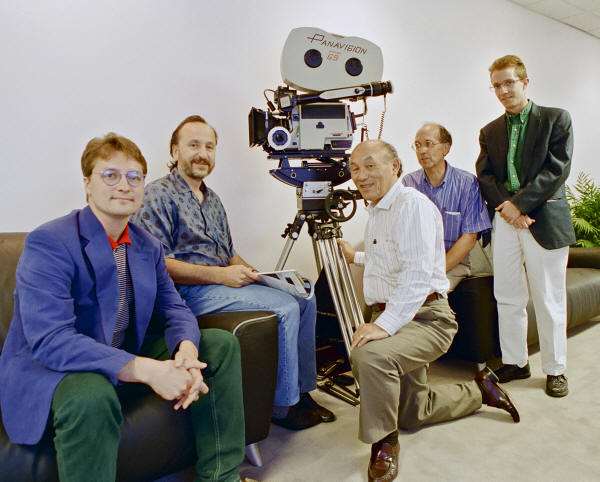 Visiting
Panavision in Tarzana. New System 65 camera in lobby. From left: Thomas Hauerslev, Mikael Salomon, Tak Miyagishima,
Greg Russin and John Wolthuis Visiting
Panavision in Tarzana. New System 65 camera in lobby. From left: Thomas Hauerslev, Mikael Salomon, Tak Miyagishima,
Greg Russin and John Wolthuis12.10.1994. Our day at Panavision Inc developed from a 2 hour visit into a full day among people committed to 70mm film and 65mm cinematography. We started our 10 AM meeting with Mr Gregory Ruzzin. Greg explained the history of Panavision Inc, gave us an extraordinary thorough tour in the building and gave us some memorabilia from the day. In the cinema, that also serves as a school, we sat down and saw a Camera 65 print of "Ben Hur" (Chariot Race scene) and the Norwegian 70mm short "A Year Along The Abandoned Road" filmed during 14 months with a Super Panavision 70 camera and a 50mm lens. With us, at the cinema, was senior vice president Takuo "Tak" Miyagishima who had been with Panavision Inc since day one. Danish cinematographer Mikael Salomon ("Far and Away") had also come to Panavision to meet us. He was working on "Zorro" with Andy Garcia. Tak told Mikael he could have the 65mm cameras for the price of 35mm cameras, but nothing was settled and we all laughed. Before we left Panavision we had the opportunity to see the original Sphero Panatar 450mm lens built for the mirage sequence in "Lawrence of Arabia". No need to say that Panavision Inc has a very large stock of 65mm cameras available. Everything is kept up to date and ready to film. The biggest surprise to me was the compact size of the new Panavision Super 70 camera. That night we were invited by the Leimeters to The Magic Castle in Hollywood. An amazing evening, a suit and tie event, with magicians doing tricks right in front our very eyes. It was simply flabbergasting to see card tricks, rubber band tricks and coin tricks in so many variations. Truely a magical evening. 13.10.1994. This was our 11th day of the promotion tour. We were both very tired. However, every day seemed like a new adventure and it gave us strength. First stop was the club house of American Society of Cinematographers and office of American Cinematographer. The original 128' Todd-AO "bug eye" lens was exhibited in the conference room. Serial number #5. A very large lens to say the least. Both Johan and I bought some old copies of American Cinematographer. In the afternoon we had a meeting with chief projectionist Mike Shaw and Bob in the Westwood Village. Two major 70mm cinemas are located here opposite each other. The Bruin and the (Fox Westwood) Village. After a tour at the projection room Johan left the party to visit Mr Paul Rayton, chief projectionist at the Hollywood Galaxy 6. Mike, Bob and I visited some cinemas in the Westwood area all equipped with 70mm and DP70. We came home very late as we spent time shooting night photography of cinemas with neon signs. |
|
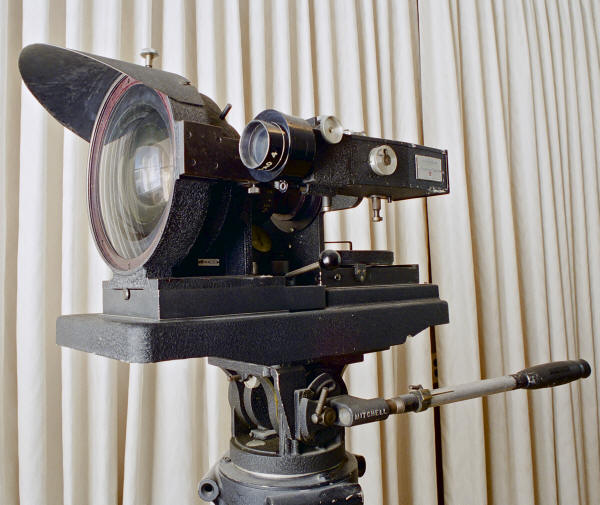 The
lens that started it all. The Todd-AO 128 dgr "Bug Eye" lens on display at
the ASC Clubhouse. The
lens that started it all. The Todd-AO 128 dgr "Bug Eye" lens on display at
the ASC Clubhouse.14.10.1994. We spent our last full day in Los Angeles with Mr Fritz Herzog, motion picture collection assistant from the Margaret Merric Library and Dick Vetter & Darryl. This is where The Academy of Motion Picture Arts and Sciences keep all their memorabilia. It is built inside an old water work. The afternoon was a treat. A presentation tour at the Academy's cinema; Samuel Goldwyn Theater. 1012 red seats, red curtain, perfect sightlines and a No Popcorn policy. Johan speeded off with Paul Rayton to DTS to find out if any 70mm prints of "My Fair Lady" was available with DTS time code. It turned out not to be true. We saw "Mary Poppins" at a special 30th year anniversary reunion screening the same evening. Before the film, however, we had just one more visit to make; at Amblin Pictures on the Universal lot in Universal City. Mr Spielberg was not at home, but we left our material for him to see. 15.10.1994. They day of "The Broadway Tour". Side by side in the Spanish speaking area of Down Town you find one cinema cathedral after another. I had never expected to see very large cinemas in these days. Grand names, all once the "crème de la crème" of cinema going in LA. State, Los Angeles, Million Dollar, Roxie, Cameo, Arcade, Palace, Globe, Tower, Rialto, Orpheum and United Artists. Many are closed, but some are still open. It's a wrap boys. Going home. Sleep for two weeks. |
|
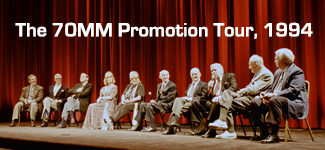 • Go to The 70mm Promotion Tour: San Francisco & Los Angeles 1 - 15 October 1994 |
|
|
Go:
back
- top
-
back issues Updated 22-01-25 |
